Here you will find the frequently asked questions. We try to answer your questions related to modern orthodontic treatments. If the questions below will not cover your case, please do not hesitate to contact us from the contact page and we will get back to you as soon as possible.
What is Orthodontics?
Orthodontics is the specialty of dentistry that deals with the diagnosis, prevention and treatment of all types of dental and skeletal abnormalities, always in relation to harmony and facial aesthetics.
Which is the difference between the Orthodontist and the Dentist?
The Orthodontist is a Dentist who is specialized for at least 3 more years in the science of Orthodontics and his degree is recognized by the Greek state.
At what age the first orthodontist check should take place?<br />
The first check is recommended at the age of 6-7 years.
Is it possible that the orthodontic problem will be self-healed as my child grows up?
The answer is NO since jaws age backwards. Generally as the person ages the available space for rise or straightening, decreases, due to the fact that the front permanent teeth apply pressure on the back teeth. The orthodontic problems in either children or adults gets worse over the years. The treatment cost is often less expensive than dental care one will later need (eg bridges or implants) to address problems caused by the postponement of necessary orthodontic treatment at an early age.
What are the benefits of an early treatment ?
- Bigger chance of avoiding extraction of permanent teeth
- Better control of skeletal problems since before adolescence the orthodontist can control and affect skeletal growth.
- Better tissues’ response to therapy.
- Greater rate of adaptation of young patients in the mechanisms and better cooperation.
- Practically easier treatment because of fewer obligations of students in primary school than those in high school.
- Younger children are not ashamed and generally do not have the inhibitions of older ones.
- When treatment starts early, in adolescence it has almost finished and adolescents have bigger confidence, due to the better appearance of their mouth and generally their face.
- Adult patients, to whom the skeleton has already been shaped, are frequently led to treatment with extractions of permanent teeth or in cases where there are skeletal problems they may need a surgery.
What are the characteristics that show that I am in need of braces?
The upper front teeth rely forward towards the outside as regard to the lower teeth (Anterior bite)
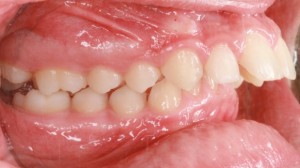
When i close my mouth the upper teeth overlap the lower ones (Deep bite)
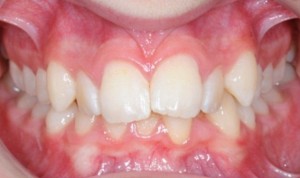
The upper teeth are behind or inside the lower front teeth (Rear bite)
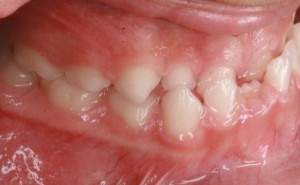
The upper and lower front teeth have a gap when they close together (Open bite)
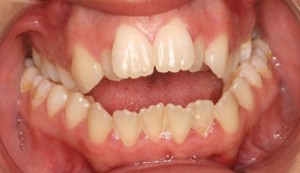
Crowded teeth
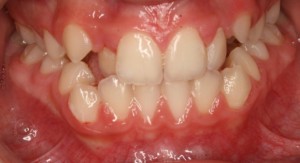
The middle upper line does not coincide with the middle lower line
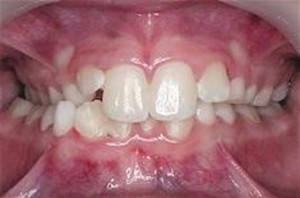
Thumb-sucking habit that continues after the age of 6-7

Difficulty when chewing

Extensive teeth abrasion

Transposition of the lower jaw towards the one side when it contacts with upper teeth
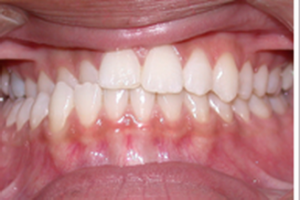
Gap between teeth

Gnashing teeth, jaws that make noise and some difficulty when speaking.

Prolonged stay of baby teeth or premature loss because of caries or trauma

Μπορεί μια έγκυος να κάνει ορθοδοντική;
Women who become pregnant during orthodontic can continue treatment. These patients should necessarily inform the treating orthodontist for pregnancy even if they are not fully confirmed.
In each case, X-rays, exports and other dental work are completely contraindicated in the first trimester of pregnancy.
It is advisable not to start the treatment in the first trimester of pregnancy in women with severe discomfort during this period. If a pregnant woman so wishes, she may begin the orthodontic treatment if all data are correctly evaluated in both treatment, and pregnancy.
Due to the fact that pregnant women generally have slightly increased tendency to gum disease they should thoroughly brush their teeth and follow the oral hygiene instructions designated by the orthodontist.
How long does an orthodontic treatment take?
The duration of the treatment varies depending on the type and severity of the abnormality. In children it usually lasts longer than in adults, due to the growth of the jaws and teeth eruption.
Is the orthodontic treatment painful?
Categorically NO. The first 2 days after each visit to the clinic, the teeth are somewhat susceptible to chewing and when they come into contact. In no case, however, braces or wires used to move the teeth do not hurt. The irritation observed is relatively mild and if necessary can be treated by taking common painkillers.
What does children's Orthodontics include?
Children’s orthodontic treatment can be divided in three main categories:
Preventive orthodontic treatment
It is for children of 6-8 years and aims to try preventing the creation of some future orthodontic problem.
Repressive orthodontic treatment
It aims at repressing an orthodontic problem that has occurred and is at an early stage.
Restorative orthodontic treatment
It is the comprehensive orthodontic treatment after the creation and installation of an orthodontic problem.
Why is it so important?
Orthodontic is necessary mostly for reasons of health and prevention of problems of the teeth and the stomatognathic system and less on the aesthetic improvement of the person. Although aesthetics basically is the reason to drive a child or an adult to the orthodontist, in fact it is the least important because prevention and orthodontic treatment should be done for the following:
* Crooked and crowded teeth are difficult to clean, resulting in greater risk of cariogenic, gingivitis and periodontitis. Over time, these diseases of the dental tissue, may even result in the loss of teeth.
* Poor convocation can create headaches.
* Proper bite/closure of the jaws helps talking and chewing.
* With the proper arrangement of the teeth, you help the general dentist to perform dental work, such as fillings, bridges, gingival and periodontal treatments.
* Skeletal problems affect the smooth operation of oral joints, thus creating a form of arthritis which is manifested by pain, headache and noise during chewing or when you open and close your mouth.
* When a problem in the teeth or jaw remain incurable, it has direct influence on the symmetry of the face (profile – en face).
* Increase of the confidence of a person due to the fact that the treatment achieves the restoration of a harmonious image to the face, lips, teeth and smile.
What do we do in the first visit?
During the first visit it will be determined if there is a need for orthodontic treatment.
If any orthodontic problem is found, in the next appointment we will be retrieving diagnostic data. These data are necessary for the detailed study of the case, the exact diagnosis and the establishment of personalized treatment plan. In addition, they serve as a reference point, the position of the teeth and the shape of the profile and smile at the time of initiation of the treatment. They typically include:
- Intraoral photographs and facial photos
- A panoramic and side cephalometric radiography and, or other appropriate radiographies
- Fingerprinting for the manufacturing of the molds of the teeth
If there is already a radiograph, it is advisable that you bring it with you on the first visit
What happens when it is not the time to start the treatment?
All patients who are not in a suitable age to start the therapy are re-evaluated in a six months basis.
What is the cost of the Orthodontic Treatment?
The total cost of the orthodontic treatment depends on the following:
- the difficulty of the orthodontic anomaly
- the duration of the treatment
- the type of orthodontic appliances to be used (metal or transparent or linguistic braces (Incognito & Orthocenter) or aligners.
and it is determined by the orthodontist after a detailed examination of the patient.
The cost of the orthodontic treatment should not be an obstacle to lose the opportunity to have a beautiful and healthy smile. Therefore, we prepare an affordable and cost effective financial plan.
What are the conditions for a successful treatment?
The success of the orthodontic treatment requires a specialist orthodontist and a consistent patient. The patient is consistent during the course of the treatment, when he or she follows the instructions of the orthodontist on the use of orthodontic devices, and doesn’t miss appointments.
What happens during a typical visit?
We typically do minor modifications to braces and wires. We change the position of a hook or we add another very small part. These visits are usually short and end with informing the patient or parent for the course of the treatment.
Is there a possibility that our wisdom teeth will cause orthodontics problems again after the treatment?
Since wisdom teeth are the last teeth to erupt in your mouth at the age of 16-18 years, it is very likely to erupt and not find sufficient space to take their positions in the jaws. This can lead to crowding teeth particularly in the lower incisors. So it is very important to wear the retainer mechanisms in accordance with our instructions, to thereby restrain the pressure of the wisdom teeth and keep the remaining teeth in their ideal positions.
